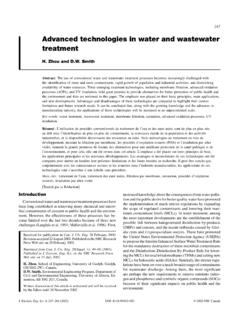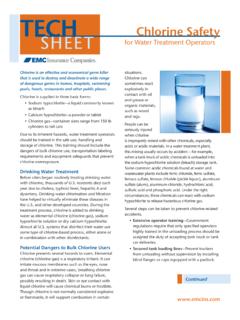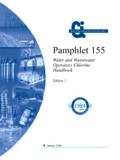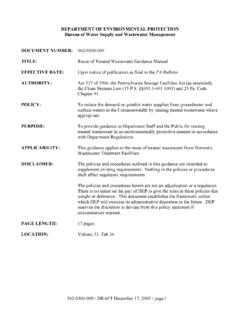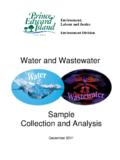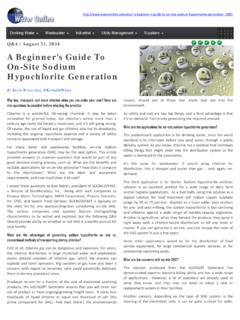Transcription of APPLICATION OF OZONATED WATER …
1 APPLICATION OF OZONATED WATER technology FOR IMPROVING QUALITY AND safety OF PEELED SHRIMP MEAT A Thesis Submitted to the Graduate Faculty of the Louisiana State University and Agricultural and Mechanical College in partial fulfillment of the requirements for the degree of Master of Science in The Department of Food Science by Amrish Suresh Chawla Bachelor of technology in Dairy technology Gujarat Agricultural Univeristy, India, 2002 August 2006 ii DEDICATION To my parents Meena and Suresh Kumar Chawla and my sister Shuchi Chawla for their love, support and encouragement. iii ACKNOWLEDGEMENTS Most useful work is not accomplished by a single person or by chance. Much effort and devotion from many people has been put into this research to get it published. I would like to thank all those to whom I owe even a little time, material and support from my heart.
2 First of all, I am deeply thankful to Dr. Jon W. Bell my major advisor, for his support and encouragement during my Masters research. I thank you for believing in me when I was struggling. I thank you for your patience, vision and constructively critical eye. I appreciate your time, vast knowledge and skills in different areas in the writing of this thesis. I would also like to thank the other members of my committee Dr. Marlene E. Janes, Dr. Witoon Prinyawiwatkul, and Dr. Zhimin Xu for teaching me so much and encouraging me along the way Most importantly, I would like to thank my friends who have stood by me and have always encouraged me and guided me when I most needed their support. I would like thank God for giving me the inspiration and strength. Special thanks, to my family members for always supporting me and encouraging me.
3 My appreciation extends to all the authors of references that provided knowledge, critique, experiences and ides to help this research. Acknowledgement is also made for the following: 1.) The National Fisheries Institute Scholarship Program and LA Sea Grant College Program (NOAA Grant No. NA16RG2249) for project funding. iv 2.) Air Liquide America, LLP, for use of Ozone Sanitation System, Model No. Model AGW 1500 G. 3.) DelOzone Inc. for technical help with Ozone Sanitation System. 4.) Paul Piazza and Sons. Inc. New Orleans (LA). v TABLE OF CONTENTS LIST OF LIST OF CHAPTER 1. 2. LITERATURE Shrimp Ozone Developing Ozone vs. Ozone APPLICATION in Biogenic Amine Sensory Thiobarbituric Acid Reacting Substances (TBARS) Listeria. in Summary of 3. DEVELOPMENT OF A PROCESS TO MEASURE OZONE CONCENTRATIONS IN PROCESSING WATER AT THE POINT OF PRODUCT Materials and Results and 4.
4 PROCESS OPTIMIZATION FOR APPLICATION OF OZONATED WATER IN SHRIMP Materials and Results and vi 5. EFFECTS OF OZONATED WATER TREATMENT ON QUALITY, SHELF LIFE AND safety IN PEELED SHRIMP Materials and Results and APPENDIX : SENSORY vii LIST OF TABLES Summary of the properties of Verification of dissolved ozone results from the flow-through sensor with chemical measurement Means and standard deviations for proximate composition of commercially peeled shrimp meat (pooled samples)..54 Means and standard deviations for proximate composition of commercially peeled shrimp meat (pooled samples)..70 viii LIST OF FIGURES Oxidation reactions of compounds during ozonation of Basic ozone Generation of histamine, putrescine, and cadaverine from their corresponding decarboxylated amino Dissolved ozone (dO3) measurement system using a flow cell and dO3 Single-pass design to produce OZONATED Ozone concentration and WATER temperature leaving single pass Changes in free chlorine and iron content of ozone treated Recirculation design to produce WATER with increased ozone Flow diagram of peeled shrimp processing in Recirculation setup to produce OZONATED Setup for flow-thru process using a flow cell and dissolved ozone (dO3)
5 Matrix of concentration and contact times for APPLICATION of dO3 using soak and spray Aerobic plate counts using soak APPLICATION at different ozone concentrations and contact Aerobic plate counts using spray APPLICATION at different ozone concentrations and contact Comparison of bacterial reduction (from control) between soak and spray APPLICATION at different ozone concentrations and contact Comparison of Pseudomonas flourescens reduction (from control) between soak and spray APPLICATION at different ozone concentrations and contact ix TBARS values for peeled shrimp soaked and sprayed with OZONATED WATER at different ozone concentrations and contact Aerobic plate counts of peeled shrimp soaked in 3ppm OZONATED WATER for 60 Biogenic amine production in peeled shrimp soaked in 3 ppm OZONATED WATER for 60 TBARS Values of Shrimp Soaked in 3ppm OZONATED WATER for 60 Shrimp inoculated with Listeria monocytogenes strains soaked in 3 ppm OZONATED WATER for 60 Percentage sensory scores of shrimp odor soaked in 3ppm OZONATED WATER for 60 Percentage sensory scores of shrimp appreance soaked in 3ppm OZONATED WATER for 60 Gas Chromatograph of PFP derivatives of untreated day 15 shrimp extract on DB-210 Gas
6 Chromatograph of PFP derivatives of untreated day 15 shrimp extract on HP-225 x ABSTRACT Ozone is an effective sanitizing agent against a broad spectrum of pathogenic and spoilage organisms. Optimization of treatment applications of OZONATED WATER is needed for increased use in the food industry. An experimental apparatus and process has been developed to digitally measure ozone concentrations in processing WATER at the point of product APPLICATION . Two APPLICATION methods were evaluated. Ozone concentrations were measured rapidly at the point of product APPLICATION . Shrimp samples were either sprayed or soaked for 20, 40 or 60 seconds with similar volumes of WATER with dissolved ozone levels of 1, 2, or 3 ppm. Microbial destruction using aerobic plate counts (APC), and lipid oxidation using the TBARS test, was measured to determine an optimal treatment.
7 Lowering the WATER temperature to 10 C facilitated the production of elevated levels of dissolved ozone (dO3), whereas high chlorine levels reduced dO3. The soaking treatment resulted in greater bacterial reduction than the spray treatment of peeled shrimp, and APPLICATION time had little effect at low concentrations of dO3. Well handled shrimp samples were then treated within 24 h of harvest using the optimal treatment of soaking in 3 ppm for 60 s. Peeled shrimp were sampled at two day intervals to evaluate APC and rancidity and at 3 day intervals for bioamines (putrescine and cadaverine) using gas chromatography (GC). Sensory quality changes were evaluated using consumer sensory testing. A Listeria monocytogenes inoculation study was also conducted. xi Treated shrimp took 16 days to reach bacterial loads of 107 CFU/g as compared to untreated shrimp which showed these levels at day 12.
8 Day 12 and day 15 untreated shrimp were rejected by a majority of the consumer panel and treated shrimp were not, based on their odors of decomposition. These rejected untreated shrimp showed > ppm putrescine and > ppm cadaverine. Untreated shrimp reached spoilage levels of 107 CFU/g 4 days before treated samples during iced storage (12 vs. 16 days). Shrimp inoculated with L. monocytogenes serotype (1/2a) and L. monocytogenes serotype (4b) resulted in a >104 CFU/g reduction after treatment. As expected oxidative rancidity did not increase in any of these studies. 1 1. INTRODUCTION Shrimp has surpassed canned tuna as the most popular seafood consumed in the : however, most of this shrimp is imported. The state of Louisiana leads the nation in shrimp production at over 210 million pounds a year, and is the second highest producing state of finfish at billion pounds annually (NMFS, 2006).
9 High product quality is a critical priority for seafood processors. Improvements in product quality, safety , and shelf life result in increased product reception and consumption, decreased discards and loss, and protection from regulatory actions. Shrimp is the most economically valuable fishery in Louisiana, and mechanically peeled and frozen shrimp accounts for the major product form processed in the state and the Gulf of Mexico region (Schwab, personal communication, 2005). However the viability of the domestic shrimp industry is under constant economic pressure from the high volumes of hand peeled and low cost imported shrimp (Anon, 2004) Improved product quality is necessary for the domestic industry to compete with the imported product and support national shrimp industry marketing initiatives (DeSantis, 2003).
10 The wild shrimp industry is also under constant threat from aquacultured shrimp as it is of a high quality and readily available. The high volumes of shrimp landings in the Gulf of Mexico waters has resulted in the development of high volume mechanical peeling operators. Due to the variable pre and post harvest conditions of the wild shrimp fisheries, wild shrimp can develop increased levels of spoilage bacteria. Using OZONATED WATER in the peeling operations presents an opportunity to reduce 2 bacterial levels and improve the quality and shelf life of peeled shrimp. This high quality shrimp will present the shrimp industry better chances to compete with the low cost imports. Ozone is a USFDA and USDA approved antibacterial agent that can be applied to food products (FDA, 1982; USDA, 1997). Ozone has seen use in the food processing industry as gaseous ozone and dissolved in WATER as OZONATED WATER .
